- Umang Sagar
- Bridge & Roads, Place, Recent article
Howrah Bridge: Connecting Past And Present
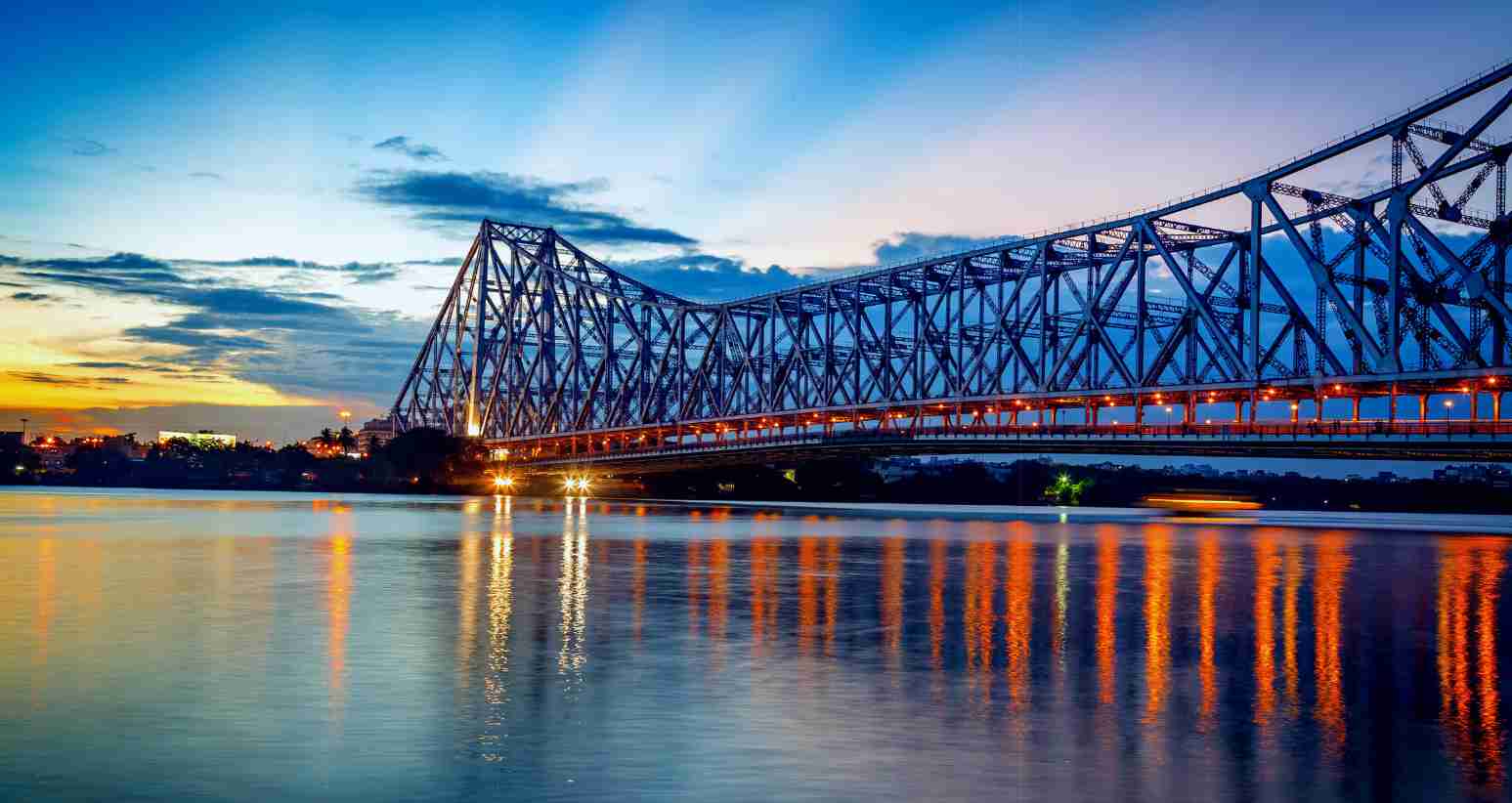
Introduction
Nestled along the banks of the majestic Hooghly River, the city of Kolkata proudly boasts a mesmerizing architectural marvel that has become synonymous with its identity—the Howrah Bridge. Spanning the river like a colossal gateway, this magnificent steel cantilever bridge stands as a testament to human ingenuity, captivating the hearts and minds of all who encounter its awe-inspiring presence.
With a history deeply rooted in the annals of time, the Howrah Bridge has not only been a vital transportation link but also an emblem of Kolkata’s rich cultural heritage. This article endeavours to explore the bridge’s fascinating journey, from its historical origins and intricate design to its enduring significance as an iconic symbol of the city.
The Howrah Bridge, initially known as the “New Howrah Bridge,” traces its roots back to the early 20th century when Kolkata, then known as Calcutta, was the capital of British India. The need for a bridge to connect the bustling city of Howrah with its Kolkata counterpart became increasingly evident as the metropolis flourished and trade thrived. The visionary engineer R.G. Thomas and his team undertook the monumental task of creating a structure that would not only facilitate transportation but also stand as a testament to architectural brilliance.
The construction of the Howrah Bridge commenced in 1936, and its completion in 1942 marked a momentous achievement in the realm of civil engineering. The bridge’s design, a splendid fusion of cantilever and suspension principles, stands as a testament to the remarkable craftsmanship and meticulous planning employed during its creation. The colossal steel trusses, supported by intricate lattice girders and colossal pylons, exemplify both strength and elegance.
As the years passed, the Howrah Bridge assumed a crucial role in Kolkata’s development, forever transforming the city’s transportation landscape. It became a lifeline, connecting the bustling neighbourhoods of Howrah and Kolkata, and facilitating the smooth flow of people, goods, and ideas. Commuters, from the humblest pedestrians to bustling buses, trams, and even the iconic yellow taxis, have traversed its expanse, making it an integral part of their daily lives.
Beyond its functional purpose, the Howrah Bridge has etched its mark on the cultural tapestry of Kolkata. It has inspired countless artists, writers, and filmmakers who have immortalized its grandeur through various creative mediums. Paintings, poems, novels, and films have celebrated the bridge’s magnificence, capturing its architectural splendour and the emotions it evokes in those who traverse its path.
Moreover, the Howrah Bridge has become an iconic landmark that beckons tourists from far and wide. Visitors to Kolkata find themselves irresistibly drawn to its magnetic presence, standing in awe of its scale and the panoramic views it offers. The bridge has become an emblem of the city’s heritage, encapsulating its resilience, spirit, and indomitable charm.
Preserving this magnificent structure is a testament to Kolkata’s commitment to safeguarding its historical treasures. Meticulous efforts have been undertaken to ensure the longevity of the Howrah Bridge, with regular maintenance and restoration projects carried out to protect its grandeur for future generations.
As we delve deeper into the captivating narrative of the Howrah Bridge, we will uncover fascinating facts and figures, revealing the bridge’s monumental scale and the engineering prowess that brought it to life. We will also explore the unforgettable events and celebrations that have graced its iconic span, leaving an indelible mark on the collective memory of Kolkata’s inhabitants.
Furthermore, we will glimpse into the future prospects of the Howrah Bridge, as it adapts to meet the changing needs of the city. Innovative plans and architectural considerations continue to shape its evolution, ensuring its relevance and functionality for generations to come.
Join us on an enchanting journey through time and space as we unveil the captivating tale of the Howrah Bridge. Together, let us discover the historical legacy, architectural splendour, and cultural significance of this iconic landmark, which stands tall as a testament to human achievement and Kolkata’s enduring spirit.
Historical Background: Tracing The Origins Of Howrah Bridge
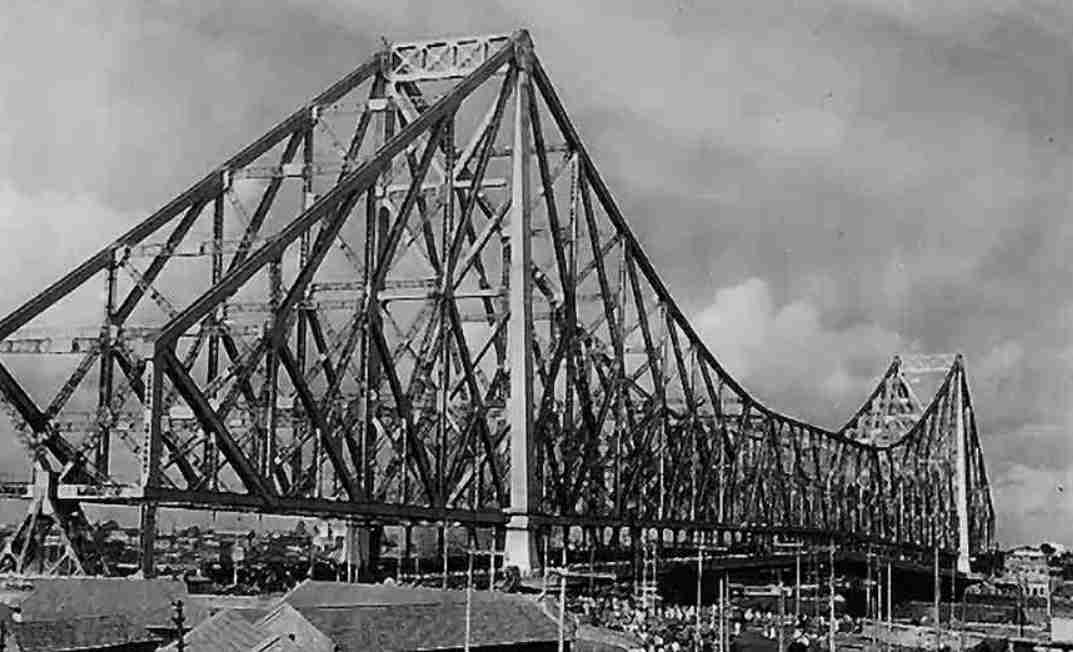
The Howrah Bridge, an iconic symbol of Kolkata (formerly known as Calcutta), is not just a remarkable feat of engineering but also a significant architectural marvel. With a fascinating history and impressive construction techniques, this bridge has become an integral part of the city’s identity. Let’s delve into the captivating story of the Howrah Bridge and explore its architectural brilliance.
The genesis of the Howrah Bridge can be traced back to the early 20th century when the Chief Engineer of the Port Trust, Mr. J. McGlashan, envisioned replacing the existing pontoon bridge with a permanent structure. The pontoon bridge posed difficulties for north-south river traffic, prompting the need for a more efficient and durable crossing. However, the outbreak of World War I in 1914 delayed the initiation of construction plans.
In 1926, a commission led by Sir R. N. Mukherjee recommended the construction of a suspension bridge across the River Hooghly. The design for the bridge was entrusted to Mr. Walton of M/s Rendel, Palmer & Tritton. The task of construction and erection was awarded to M/s Cleveland Bridge & Engineering Company in 1939. Unfortunately, World War II broke out, redirecting the steel meant for the bridge to support the war effort in Europe. This setback meant that only a fraction of the required steel, a mere 3,000 tons out of 26,000, was supplied from England.
Despite the challenges posed by the war and the imminent Japanese threat, the then-government of India, under British rule, decided to forge ahead with the construction of the bridge. Tata Steel was approached to supply the remaining 23,000 tons of high-tensile steel. Rising to the occasion, Tata Steel developed a new type of steel specifically for the bridge, known as Tiscrom. The entire consignment of 23,000 tons was delivered in a timely manner, showcasing the ingenuity and determination of the engineers involved.
The responsibility for fabrication and erection was entrusted to a local engineering firm based in Howrah, the Braithwaite, Burn & Jessop Construction Company. The bridge’s foundation involved the construction of two anchorage caissons, each with dimensions of 16.4 meters by 8.2 meters, including two wells measuring 4.9 meters square. These caissons were meticulously designed to allow for temporary enclosure by steel diaphragms, enabling work to be conducted under compressed air if necessary.
During the sinking of the caissons, a significant incident occurred, shaking the ground and registering as an earthquake on the seismograph at Kidderpore. The incident resulted in the destruction of a Hindu temple located on the shore, though it was later rebuilt. As the caissons were being cleared, a plethora of objects from various periods in history was discovered, including anchors, grappling irons, cannons, cannonballs, brass vessels, and even coins dating back to the East India Company. This excavation process offered a unique glimpse into the past.
The sinking of the caissons was carried out around the clock, at a rate exceeding one foot per day. The precision involved in this task was exceptional, with an accuracy of within 50-75 millimetres of the true position. The caissons descended through soft river deposits until they reached a stiff yellow clay 26.5 meters below ground level. Once the caissons penetrated 2.1 meters into the clay, each shaft was plugged with concrete after individual dewatering. Approximately 5 meters of backfilling was then done in adjacent shafts.
The main piers on the Howrah side were sunk using open-wheel dredging techniques, while those on the Kolkata side required compressed air to counter the running sand. The air pressure was maintained at around 40 pounds per square inch (2.8 bar), necessitating the employment of approximately 500 workers. In instances where excessively soft soil was encountered, symmetrical shafts were left unexcavated to ensure strict control. Conversely, in very stiff clays, many internal wells were completely undercut, allowing the caissons’ weight to be supported by the outside skin friction and the bearing under the external wall. The skin friction on the outside of the monolith walls was estimated at 29 kilonewtons per square meter, while the loads on the cutting edge in the clay above the founding stratum reached 100 tonnes per meter.
By the end of 1940, the construction of the cantilevered arms commenced and was completed by mid-1941. The two halves of the suspended span, each measuring 282 feet (86 meters) in length and weighing a staggering 2,000 tons, were built in December 1941. The bridge was erected by starting at the two anchor spans and progressing toward the centre using creeper cranes that moved along the upper chord. To join the two halves of the suspended span, 16 hydraulic jacks with an impressive 800-ton capacity each were employed.
The Howrah Bridge, with its awe-inspiring construction process and innovative engineering techniques, stands as a testament to human ingenuity and determination. It is estimated that the entire project cost around ₹25 million (£2,463,887), making it a pioneering endeavour in bridge construction, especially in India.
However, due to fears of attacks by Japanese planes during World War II, the government opted not to hold a formal opening ceremony for the bridge. Instead, the first vehicle to traverse the bridge was a solitary tram, marking the beginning of a new era in Kolkata’s transportation infrastructure.
The Howrah Bridge, often referred to as the “Gateway to Kolkata,” connects the city to the Howrah Station, serving as a vital lifeline for commuters and a symbol of the city’s rich history and architectural brilliance. Its remarkable design and engineering have made it an enduring icon, attracting visitors from around the world who marvel at its grandeur and historical significance.
Overcoming World War Challenges: A Testimony Of Resilience
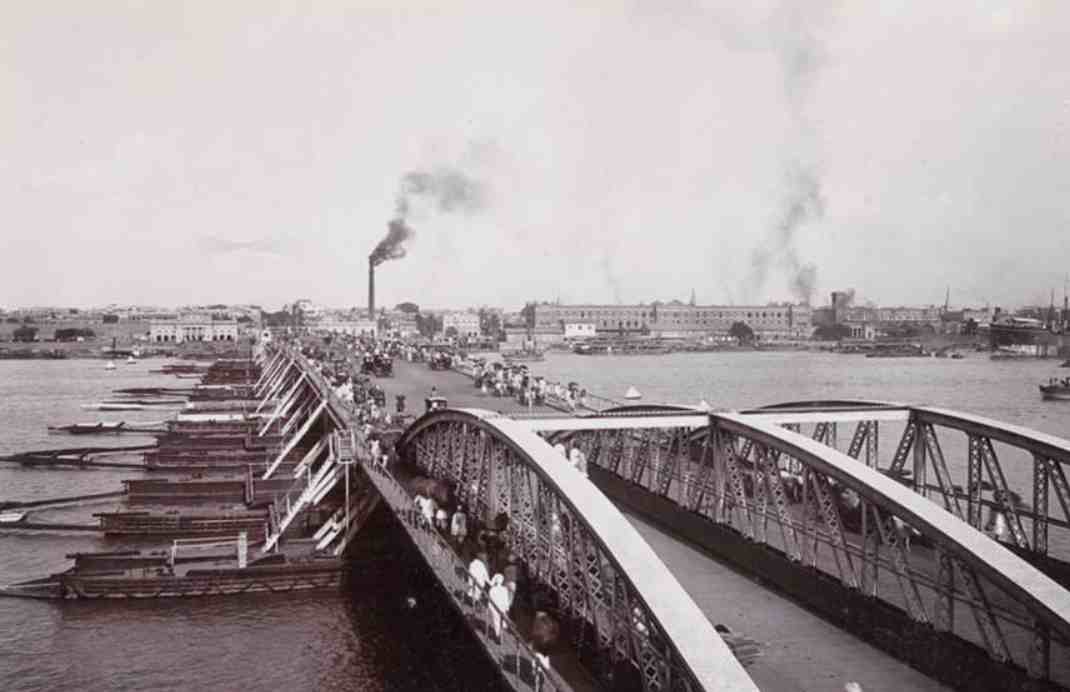
The construction of the Howrah Bridge faced formidable challenges with the outbreak of World War II in 1939. The original plan to import steel from England was disrupted as the steel was redirected to support the war efforts in Europe. With only 3,000 tons of the required 26,000 tons of steel available, the project faced an uncertain future. However, undeterred by these setbacks, the Indian government and the engineers involved in the project embarked on a remarkable journey to overcome these challenges and ensure the completion of this architectural marvel.
In the face of the looming Japanese threat and the scarcity of resources, the government sought an alternative solution to acquire the necessary steel for the bridge. They turned to Tata Steel, a renowned Indian steel company known for its expertise and innovative approaches. Tata Steel stepped up to the task and played a pivotal role in salvaging the project.
To fulfil the steel requirements, Tata Steel undertook the ambitious task of producing 23,000 tons of high-tensile alloy steel, which would be instrumental in the construction of the bridge. This specially developed steel, known as Tiscrom, showcased the technical prowess and dedication of Tata Steel’s engineers and researchers. The production of such a significant quantity of high-quality steel within a short timeframe was an exceptional achievement, especially considering the challenging circumstances of wartime.
The development of Tiscrom was a testament to Tata Steel’s commitment to innovation and its ability to adapt to adverse conditions. The steel had to meet stringent requirements to ensure the bridge’s structural integrity, durability, and resilience. Tata Steel’s engineers worked tirelessly to create a steel composition that would withstand the test of time and provide the necessary strength for the Howrah Bridge.
The successful collaboration between the Indian government and Tata Steel was a remarkable feat of determination, resourcefulness, and national pride. Despite the scarcity of resources and the turbulent times, they managed to secure the steel needed to complete the bridge. This collaborative effort not only ensured the realization of the Howrah Bridge project but also showcased the indomitable spirit of the Indian people and their commitment to progress and development.
The completion of the Howrah Bridge against all odds stands as a testament to the resilience and ingenuity of the engineers, workers, and the entire nation. It serves as a shining example of how challenges can be overcome through innovative thinking, collaboration, and unwavering determination.
The Howrah Bridge, with its Tiscrom steel and riveted construction, stands today as an enduring symbol of human achievement. It not only connects the city of Kolkata to Howrah Station but also serves as a reminder of the remarkable accomplishments that can be achieved even in the face of adversity. The bridge’s history is a testament to the collective efforts and unwavering spirit of all those involved, making it a truly remarkable engineering wonder that continues to inspire awe and admiration.
Construction And Design: The Making Of An Icon
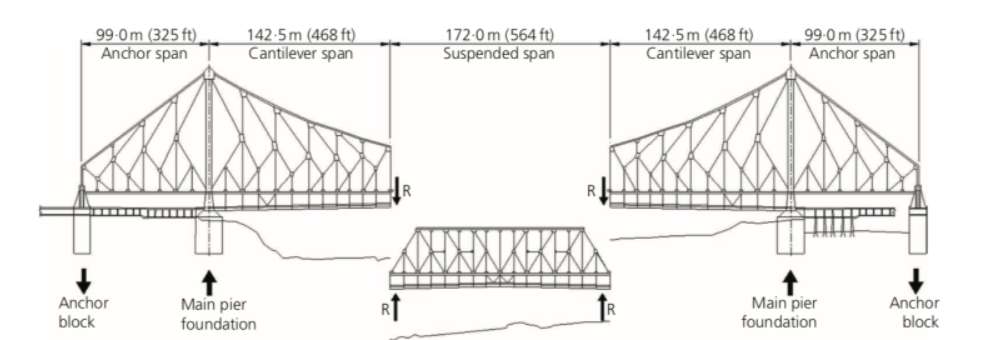
The Howrah Bridge, an architectural marvel and one of India’s most iconic landmarks, stands as a testament to exceptional engineering and innovative design. Its construction, which began in the early 20th century, involved overcoming numerous challenges and pushing the boundaries of engineering possibilities.
The concept of a permanent bridge across the River Hooghly in Kolkata emerged due to the limitations of the existing pontoon bridge, which obstructed the north-south river traffic. The visionary Chief Engineer of the Port Trust, Mr J. McGlashan, envisioned a grand structure that would replace the pontoon bridge. However, the outbreak of World War I in 1914 delayed the realization of this ambitious project.
In 1926, a commission chaired by Sir R. N. Mukherjee recommended the construction of a suspension bridge as the optimal solution. The design of the bridge was entrusted to Mr. Walton, an engineer from the firm M/s Rendel, Palmer & Tritton. The responsibility for the construction and erection of the bridge was placed on M/s Cleveland Bridge & Engineering Company, a reputed British engineering firm.
The construction of the Howrah Bridge faced significant challenges, including the impact of two world wars. During World War II, the availability of construction materials, especially steel, became a major concern. The steel originally intended to be imported from England was diverted for war efforts in Europe, leaving a mere 3,000 tons out of the required 26,000 tons available for the project. The scarcity of resources and the looming Japanese threat posed a formidable obstacle.
In the face of these challenges, Tata Steel, a leading Indian steel company, played a pivotal role in ensuring the bridge’s completion. They rose to the occasion by developing high-tensile alloy steel specifically for the construction of the Howrah Bridge, named Tiscrom. Tata Steel supplied the remaining 23,000 tons of Tiscrom steel, showcasing their innovation and commitment to the project. This collaborative effort overcame the shortage of steel and enabled the construction to proceed.
The design and construction of the Howrah Bridge were a testament to engineering excellence. The main tower of the bridge was built using single monolith caissons, massive concrete structures with dimensions of 55.31 m × 24.8 m. These caissons were sunk through soft river deposits until reaching a stiff yellow clay layer located 26.5 meters below the ground level. The accuracy achieved in sinking these colossal caissons was extraordinary, with a precision of within 50-75 mm of the true position.
To ensure stability, the caissons were designed with working chambers that could be temporarily enclosed by steel diaphragms, allowing work to be carried out under compressed air if needed. This innovative approach enabled the construction team to overcome the challenges posed by the river’s soft soil and establish a strong foundation for the bridge.
The erection of the cantilevered arms, a defining feature of the Howrah Bridge, commenced in 1940 and was completed in mid-summer of 1941. The two halves of the suspended span, each weighing an impressive 2,000 tons and measuring 282 feet (86 m) in length, were constructed in December 1941. The construction process involved starting at the anchor spans and progressively advancing towards the centre, utilizing creeper cranes moving along the upper chord. To join the two halves of the suspended span, hydraulic jacks with an 800-ton capacity were employed, ensuring a secure and seamless connection.
One remarkable aspect of the Howrah Bridge’s construction was the use of riveting instead of nuts and bolts. The entire structure was riveted together, with heated rivets hammered to create strong and durable connections. This meticulous riveting process contributed to the bridge’s strength and resilience, allowing it to withstand the test of time.
The completion of the Howrah Bridge in 1943 marked a significant milestone in engineering history. Its magnificent design, innovative construction techniques, and the collaborative efforts of engineers and companies from India and abroad made it an engineering wonder. Today, the Howrah Bridge continues to be an enduring symbol of Kolkata’s rich heritage and a source of pride for the nation, attracting visitors from around the world who marvel at its grandeur and appreciate the remarkable feats of engineering that brought it to life.
1. Overcoming Challenges:-
The construction of the Howrah Bridge faced numerous challenges, including the impact of two world wars. During World War II, the steel originally intended to be imported from England was diverted for war efforts in Europe. Only 3,000 tons of the required 26,000 tons of steel were available. Despite the scarcity of resources and the looming Japanese threat, the project persevered.
Tata Steel, a renowned Indian steel company, played a crucial role in overcoming these challenges. They developed high-tensile alloy steel known as Tiscrom, specifically for the construction of the bridge. Tata Steel supplied the remaining 23,000 tons of Tiscrom steel, showcasing their innovation and dedication to completing the project.
2. Ingenious Construction:-
The construction of the Howrah Bridge was a masterpiece of engineering. The main tower of the bridge was built using single monolith caissons with dimensions of 55.31 m × 24.8 m. These caissons had 21 shafts, each measuring 6.25 meters square. The accuracy of sinking these huge caissons was exceptional, with a precision of within 50-75 mm of the true position.
The bridge’s foundation involved sinking the caissons through soft river deposits to a stiff yellow clay 26.5 m below ground level. To ensure stability, the caissons were designed with working chambers that could be temporarily enclosed by steel diaphragms, allowing work under compressed air if required.
The erection of the cantilevered arms commenced in 1940 and was completed in mid-summer of 1941. The two halves of the suspended span, each weighing 2,000 tons and measuring 282 feet (86 m) in length, were built in December 1941. The bridge was erected by starting at the anchor spans and advancing towards the centre, using creeper cranes moving along the upper chord. Hydraulic jacks with an 800-ton capacity were utilized to join the two halves of the suspended span.
3. Riveted Construction:-
One of the most remarkable features of the Howrah Bridge is its riveted construction. Unlike modern bridges that use nuts and bolts, the entire structure of the Howrah Bridge was riveted together. This meticulous process involved joining the steel components by heating the rivets and hammering them to create a strong and durable connection. This riveted construction technique added to the bridge’s strength and ensured its longevity.
The Howrah Bridge stands tall as an architectural marvel and a testimony to the brilliance of engineering. Overcoming challenges posed by two world wars and scarcity of resources, the engineers and workers involved in its construction showcased remarkable perseverance, innovation, and skill.
The bridge’s design, ingenious construction techniques, and the use of Tiscrom steel by Tata Steel highlight the remarkable achievements of Indian engineering. The Howrah Bridge not only serves as a vital transportation link between Kolkata and Howrah but also stands as a symbol of human determination and ingenuity.
With its riveted construction, the Howrah Bridge continues to awe visitors with its grandeur and timeless elegance. It remains an iconic landmark, capturing the imagination and admiration of all who witness its engineering wonders.
Connecting Kolkata: How Howrah Bridge Transformed City Transportation

Kolkata, known as the cultural capital of India, is a vibrant metropolis with a rich heritage. As the city expanded, it faced numerous transportation challenges common to growing urban areas. However, the construction of the iconic Howrah Bridge played a crucial role in transforming Kolkata’s transportation system. This article explores the history, significance, and transformative impact of the Howrah Bridge on the city’s transportation landscape.
The concept of building a bridge over the Hooghly River in Kolkata was initially proposed in the early 19th century. The Howrah Bridge was designed to replace the outdated pontoon bridge that connected the city to its twin city of Howrah. Despite the challenging circumstances presented by World War II, construction on the bridge began in 1936 and was completed in 1943.
The Howrah Bridge, also known as Rabindra Setu, is not just a functional structure but an architectural marvel that has become an iconic symbol of Kolkata. Designed by the renowned British engineers Rendel and Palmer, the bridge stands as a testament to human ingenuity and engineering prowess. With a length of approximately 2,150 feet and a width of 71 feet, it is one of the longest cantilever truss bridges in the world.
Prior to the construction of the Howrah Bridge, commuting between Kolkata and Howrah involved relying on ferries or using a circuitous road route. These options were time-consuming and often congested, impeding the movement of goods and people. The bridge revolutionized transportation by providing a direct and efficient link between the two cities. It facilitated the seamless movement of pedestrians, vehicles, and even trams, significantly reducing travel time and congestion.
The Howrah Bridge played a vital role in boosting Kolkata’s economy by facilitating the smooth flow of goods and commerce. Its strategic location near the Kolkata Port enabled the transportation of goods to and from the hinterlands, thereby enhancing trade and industrial growth. This accessibility contributed to Kolkata’s status as a major commercial hub in eastern India.
Beyond its utilitarian significance, the Howrah Bridge holds immense cultural value for the people of Kolkata. It has become an integral part of the city’s identity and has been featured in numerous films, literature, and artwork. The bridge’s stunning beauty, particularly when illuminated at night, attracts locals and tourists alike, making it a popular landmark and a symbol of Kolkata’s vibrant spirit.
To ensure its structural integrity and safety, the Howrah Bridge has undergone regular maintenance and repairs over the years. However, with Kolkata’s growing population and increasing traffic demands, the bridge has faced challenges in accommodating the rising load. Consequently, plans for the construction of a second bridge, known as the New Howrah Bridge or the Vidyasagar Setu, were initiated in the 1970s to complement the existing bridge and alleviate congestion.
The construction of the Howrah Bridge marked a significant milestone in Kolkata’s transportation history, providing an essential link that transformed the city’s connectivity and facilitated its economic growth. As an iconic structure, it continues to be an integral part of Kolkata’s identity, symbolizing the city’s resilience, innovation, and cultural heritage. The Howrah Bridge remains a timeless testament to the power of infrastructure in shaping and enhancing urban life.
Symbol Of Kolkata: Howrah Bridge In Art, Literature, And Cinema

The Howrah Bridge, an iconic symbol of Kolkata, has left a lasting impression not only in the realm of architecture and engineering but also in art, literature, and cinema. This majestic structure has served as a muse for creative minds, inspiring numerous artistic expressions and finding its way into the hearts of people across different forms of art.
In the world of art, the Howrah Bridge has been depicted in various paintings, sketches, and sculptures. Artists have captured its magnificence, intricate design, and the play of light and shadows on its structure. The bridge’s prominent presence against the backdrop of the River Hooghly has made it a favored subject for landscape artists, who seek to capture the essence of Kolkata’s urban landscape. The vibrant colors of the bridge, its arches, and the bustling life around it have been skillfully portrayed, bringing alive the spirit of the city on canvas.
Literature has also been deeply influenced by the allure of the Howrah Bridge. Many writers, poets, and authors have used the bridge as a metaphorical backdrop in their works. Its grandeur, endurance, and the constant movement of people and vehicles on its deck have served as powerful symbols in literary narratives. The Howrah Bridge has been depicted as a connecting link, bridging the gap between different worlds or characters, and symbolizing the passage of time or the transition between old and new. It has become a literary icon that represents the spirit of Kolkata and its ever-evolving identity.
Cinema, too, has embraced the Howrah Bridge as an integral part of storytelling. The bridge has featured prominently in numerous films, both regional and national, becoming a character in itself. It’s imposing presence and distinctive architecture have provided filmmakers with a captivating backdrop for dramatic sequences, romantic encounters, and action-packed scenes. The bridge’s sheer scale and its association with the city’s identity have made it a recognizable landmark, often serving as a visual symbol of Kolkata in cinema. The Howrah Bridge has become synonymous with the city’s cinematic narrative, etching its silhouette in the memories of movie enthusiasts.
From art to literature to cinema, the Howrah Bridge has left an indelible mark on the creative landscape of Kolkata. It has become a symbol of the city’s heritage, resilience, and vibrant spirit. Artists, writers, and filmmakers have celebrated its beauty, incorporated its symbolism, and utilized its presence to evoke emotions, capture the essence of Kolkata, and narrate compelling stories.
In the realms of art, literature, and cinema, the Howrah Bridge stands tall as an iconic muse, inspiring generations of creative minds. Its architectural marvel and stories have transcended time and boundaries, making it a timeless symbol of Kolkata’s cultural and artistic identity.
Iconic Landmark: Howrah Bridge's Significance To Tourism

The Howrah Bridge, an iconic landmark in Kolkata, holds immense significance in the realm of tourism. As one of the most recognized and visited structures in India, it attracts tourists from all over the world who are captivated by its architectural brilliance and historical value. Let’s explore the various aspects that make the Howrah Bridge a must-visit destination for travellers.
Architectural Marvel: The Howrah Bridge is not just a bridge; it is a masterpiece of engineering and design. Its cantilever truss structure, spanning the mighty Hooghly River, showcases exceptional craftsmanship and innovation. Tourists are fascinated by the bridge’s massive dimensions, intricate detailing, and the skilful use of riveting techniques. The sheer scale and grandeur of the bridge leave visitors in awe, providing a visual treat for architecture enthusiasts.
Historical Significance: The Howrah Bridge is deeply entrenched in Kolkata’s history. Built during the challenging times of World War II, it stands as a testament to the indomitable spirit of the city. Tourists are intrigued by the bridge’s rich past, as it witnessed the growth and transformation of Kolkata over the years. Exploring the bridge allows visitors to connect with the city’s heritage and gain a deeper understanding of its historical journey.
Cultural Symbol: The Howrah Bridge has become an emblematic symbol of Kolkata’s cultural identity. It has been immortalized in art, literature, and cinema, depicting its significance in the city’s collective consciousness. Tourists are drawn to the bridge to experience the vibrant cultural heritage of Kolkata, which the bridge embodies. It serves as a gateway to the city’s traditions, festivals, and artistic expressions, making it a cultural hotspot for travellers.
Panoramic Views: A visit to the Howrah Bridge offers breathtaking panoramic views of Kolkata. Standing on the bridge, tourists can admire the sprawling cityscape, the shimmering waters of the Hooghly River, and the bustling activities taking place on its deck. The bridge serves as an excellent vantage point to capture stunning photographs and witness the rhythmic flow of life in Kolkata. The enchanting views from the bridge create lasting memories for visitors.
Connecting Landmarks: The Howrah Bridge serves as a vital link between Kolkata and its neighbouring city of Howrah. This connectivity makes it a strategic landmark for travellers, as it provides access to various attractions on both sides of the river. Tourists can easily explore popular destinations such as Howrah Railway Station, Dakshineswar Kali Temple, Belur Math, and the vibrant streets of Kolkata by using the bridge as a starting point. Its location enhances the overall tourist experience and facilitates smooth travel across the city.
- Cultural Events: The Howrah Bridge has become a venue for various cultural events and festivals, adding to its allure for tourists. The bridge is adorned with decorative lighting during festivals like Durga Puja, creating a mesmerizing spectacle of colours and illuminations. The vibrant atmosphere and the spirit of celebration attract tourists who wish to immerse themselves in Kolkata’s festive fervour.
The Howrah Bridge’s significance to tourism lies in its unique blend of architectural excellence, historical legacy, cultural symbolism, and breathtaking views. It serves as a gateway to Kolkata’s vibrant culture, offering a glimpse into the city’s past, present, and future. As one of the most iconic landmarks in India, the Howrah Bridge continues to captivate and enthral tourists, making it an essential stop on any Kolkata itinerary.
Preservation And Maintenance: Ensuring The Longevity Of Howrah Bridge

Preservation and maintenance are crucial aspects of ensuring the longevity and structural integrity of the Howrah Bridge, one of Kolkata’s most iconic landmarks. As a historical and architectural marvel, the bridge requires regular care and attention to preserve its grandeur and functionality. Let’s explore the various measures undertaken to safeguard and maintain this engineering wonder.
Regular Inspections: The Howrah Bridge undergoes periodic inspections conducted by a team of qualified engineers and experts. These inspections assess the overall condition of the bridge, identify any signs of deterioration or damage, and determine the necessary maintenance and repair work. Regular inspections help detect issues at an early stage, allowing for timely intervention and preservation efforts.
Structural Repairs: Over the years, Howrah Bridge has faced the challenges posed by natural elements, heavy traffic, and environmental factors. Structural repairs are conducted to address any damage or wear and tear that may compromise the bridge’s strength. This includes repairing cracks, reinforcing structural components, and replacing deteriorated materials. These repairs are essential in maintaining the bridge’s load-bearing capacity and ensuring the safety of commuters and pedestrians.
Painting and Anti-corrosion Measures: The Howrah Bridge’s distinctive colour and appearance are a result of regular painting and anti-corrosion treatments. The bridge’s steel structure is susceptible to corrosion due to its exposure to moisture and atmospheric conditions. To combat this, a protective coating system is applied to prevent rust and corrosion. Regular painting not only enhances the bridge’s aesthetics but also acts as a protective barrier, extending its lifespan and preserving its structural integrity.
Expansion Joint Maintenance: Expansion joints are crucial components of the Howrah Bridge that allow for the bridge’s expansion and contraction due to temperature changes. These joints require regular maintenance to ensure proper functionality and prevent water seepage. Sealing and replacement of damaged expansion joint elements are carried out to maintain the bridge’s stability and prevent further deterioration.
Lighting and Electrical Systems: The Howrah Bridge is adorned with decorative lighting, which adds to its charm and visibility, especially during festivals and special occasions. Regular maintenance of the lighting and electrical systems is necessary to ensure their proper functioning and safety. This includes checking electrical connections, replacing faulty bulbs, and conducting routine inspections to maintain the bridge’s captivating illumination.
Public Awareness and Safety Measures: Preserving the Howrah Bridge involves educating the public about its historical and cultural significance, as well as its role in its maintenance. Creating awareness about responsible use, discouraging vandalism, and promoting safety measures are essential in safeguarding the bridge’s longevity. Initiatives such as signage, public campaigns, and outreach programs contribute to public involvement and support in preserving this iconic landmark.
- Technological Advancements: With advancements in technology, innovative methods are being employed to enhance the preservation and maintenance of the Howrah Bridge. Non-destructive testing techniques, such as ultrasonic testing and ground-penetrating radar, are used to assess the internal condition of the bridge without causing damage. These technologies enable engineers to identify potential issues and take preventive measures more efficiently.
Preservation and maintenance efforts play a vital role in ensuring the Howrah Bridge’s longevity and continued significance as a cultural, architectural, and historical icon. By adhering to rigorous inspection schedules, conducting necessary repairs, implementing corrosion protection measures, and promoting public awareness, the bridge’s beauty and functionality can be preserved for generations to come. The dedicated efforts of engineers, maintenance crews, and public support contribute to the sustained glory of this remarkable engineering marvel.
Howrah Bridge In Numbers: Impressive Facts And Figures

The Howrah Bridge, an iconic landmark in Kolkata, India, is not only a testament to engineering excellence but also boasts impressive facts and figures that highlight its grandeur and significance. Let’s delve into the numbers that make the Howrah Bridge truly remarkable:
Length and Width: The Howrah Bridge spans approximately 2,150 feet (705 meters) across the Hooghly River, connecting Kolkata with its twin city, Howrah. With a width of 71 feet (22 meters), the bridge provides ample space for pedestrian walkways, vehicle lanes, and tram tracks.
Construction Time: Despite facing challenges posed by World War II, the Howrah Bridge was completed in just seven years. Construction commenced in 1936 and concluded in 1943, showcasing the exceptional dedication and efficiency of the engineers and workers involved.
Steel Usage: The Howrah Bridge required a significant amount of steel for its construction. Approximately 26,500 tons of steel were initially planned for the project. However, due to the diversion of steel for the war efforts during World War II, only 3,000 tons were available. Tata Steel, an Indian steel company, stepped in and developed a high-tensile alloy steel called Tiscrom specifically for the bridge, supplying the remaining 23,000 tons required.
Cantilever Structure: The Howrah Bridge is a cantilever truss bridge, a remarkable engineering feat. The bridge’s cantilever arms extend outward from the central towers without the need for any intermediate supports. The two halves of the suspended span, each weighing 2,000 tons, were joined in December 1941, creating a seamless structure.
Rivets: The construction of the Howrah Bridge relied on riveting techniques rather than nuts and bolts. Approximately 26,500 tons of rivets were used to connect the steel components of the bridge. These rivets were heated and hammered to create strong and durable connections, contributing to the bridge’s strength and longevity.
Pedestrian Capacity: The Howrah Bridge not only facilitates vehicular traffic but also provides dedicated pedestrian walkways on both sides. These walkways allow pedestrians to cross the bridge safely while enjoying breathtaking views of the river and the cityscape. The bridge can accommodate a significant number of pedestrians, making it a popular spot for leisurely walks and sightseeing.
Daily Traffic: The Howrah Bridge serves as a vital transportation link between Kolkata and Howrah, experiencing heavy traffic throughout the day. On average, more than 100,000 vehicles, including cars, buses, trucks, and motorcycles, cross the bridge daily, making it one of the busiest bridges in India.
Cultural Significance: The Howrah Bridge holds immense cultural value and is an integral part of Kolkata’s identity. It has been featured in numerous films, literature, and artworks, becoming an iconic symbol of the city’s vibrancy and spirit. The bridge’s stunning beauty, especially when illuminated at night, attracts locals and tourists alike, adding to its cultural allure.
Maintenance: To ensure the bridge’s longevity and safety, regular maintenance and preservation efforts are undertaken. The bridge undergoes inspections, structural repairs, painting, anti-corrosion treatments, and lighting system maintenance. These measures help protect the bridge from deterioration caused by environmental factors and heavy traffic.
The Howrah Bridge stands tall as an architectural marvel, boasting impressive dimensions, construction feats, and cultural significance. Its impressive statistics and numbers contribute to its iconic status, attracting visitors from around the world to witness its magnificence. As a symbol of Kolkata’s rich heritage and engineering prowess, the Howrah Bridge continues to captivate and inspire with its grandeur and remarkable achievements.
Iconic Moments: Memorable Events And Celebrations On Howrah Bridge
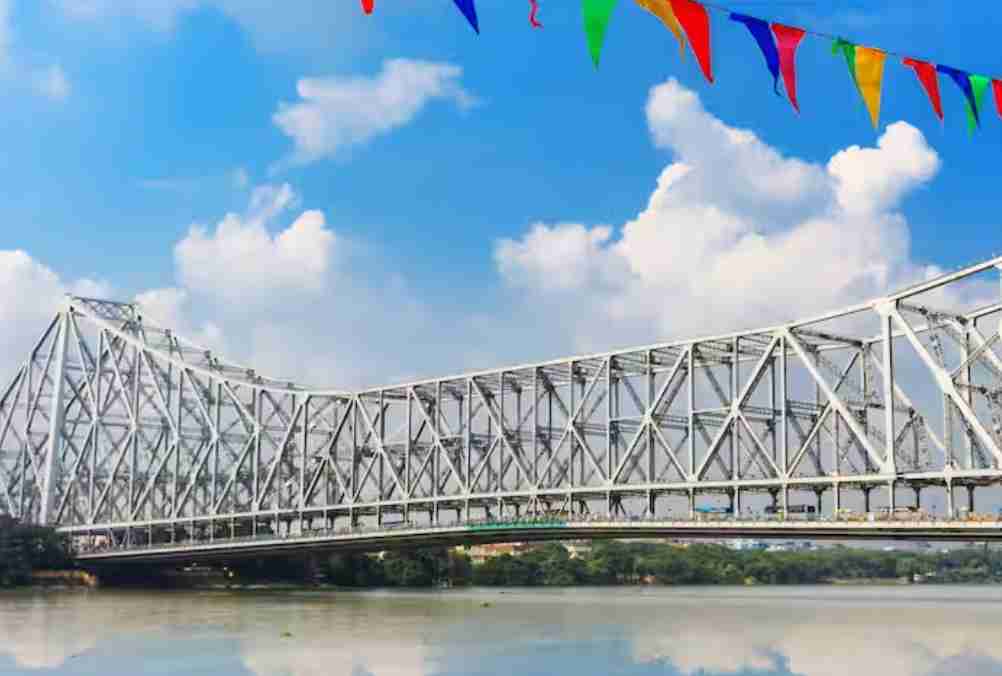
The Howrah Bridge has witnessed numerous memorable events and celebrations throughout its history. From cultural festivals to political gatherings, the bridge has served as a backdrop for significant moments that have left an indelible mark on the city’s collective memory. Let’s explore some of the iconic moments that have unfolded on the Howrah Bridge:
Republic Day Parades: The Howrah Bridge has been a key venue for the Republic Day parades in Kolkata. Every year on January 26th, the bridge comes alive with vibrant processions, floats, and performances that celebrate India’s rich cultural heritage and patriotic spirit. The bridge provides a magnificent setting for these parades, with its majestic structure and panoramic views of the river and the city.
Durga Puja Immersions: Durga Puja, one of the most important festivals in Kolkata, culminates with the immersion of beautifully crafted idols of the goddess Durga into the Hooghly River. The Howrah Bridge becomes a focal point of this grand procession, as devotees and revellers gather to bid farewell to the goddess. The bridge witnesses a sea of people, colorful processions, and enthusiastic celebrations, creating a vibrant atmosphere that showcases the city’s deep-rooted cultural traditions.
New Year’s Eve Celebrations: As the clock strikes midnight on New Year’s Eve, the Howrah Bridge becomes a hotspot for revelers and party-goers. The bridge lights up with dazzling displays of fireworks, creating a mesmerizing spectacle against the backdrop of the night sky. Locals and tourists flock to the bridge to welcome the new year with joy and enthusiasm, making it a memorable and festive occasion.
Film Shoots: The Howrah Bridge has provided a captivating setting for numerous film shoots, both in Bollywood and regional cinema. Its grand architecture and picturesque location have been featured in iconic movies, adding a touch of glamour and drama to the silver screen. From romantic scenes to thrilling chase sequences, the bridge’s timeless beauty and iconic status have made it a sought-after location for filmmakers.
Political Rallies and Protests: The Howrah Bridge has witnessed its fair share of political rallies and protests, with political leaders and activists addressing large crowds from its vicinity. It has served as a platform for voicing concerns, advocating for social justice, and mobilizing public support. The bridge’s symbolic significance and central location have made it a preferred site for political gatherings that shape public discourse and influence the course of events.
Cultural Performances: The Howrah Bridge has also been a stage for cultural performances, showcasing the diverse artistic traditions of Kolkata. Musicians, dancers, and street performers have delighted audiences with their talents, adding a touch of artistic vibrancy to the bridge’s bustling atmosphere. These impromptu performances capture the essence of Kolkata’s artistic spirit and create memorable experiences for visitors and locals alike.
Sporting Events: The Howrah Bridge has played a role in hosting sporting events and marathons, attracting athletes and sports enthusiasts from far and wide. The bridge’s long expanse and sturdy structure provide an ideal route for sporting competitions, such as the Kolkata Full Marathon. Participants showcase their physical prowess as they traverse the bridge, creating iconic moments in the realm of sports.
The Howrah Bridge has witnessed countless iconic moments that have shaped Kolkata’s cultural, social, and political landscape. It continues to be a witness to the city’s vibrant spirit and a symbol of its rich heritage. Whether it’s celebrations of festivals, cultural performances, political rallies, or cinematic experiences, the bridge stands as a cherished venue for memorable events that leave an everlasting impact on the collective memory of the people of Kolkata.
Future Prospects: Adapting Howrah Bridge For Changing Needs
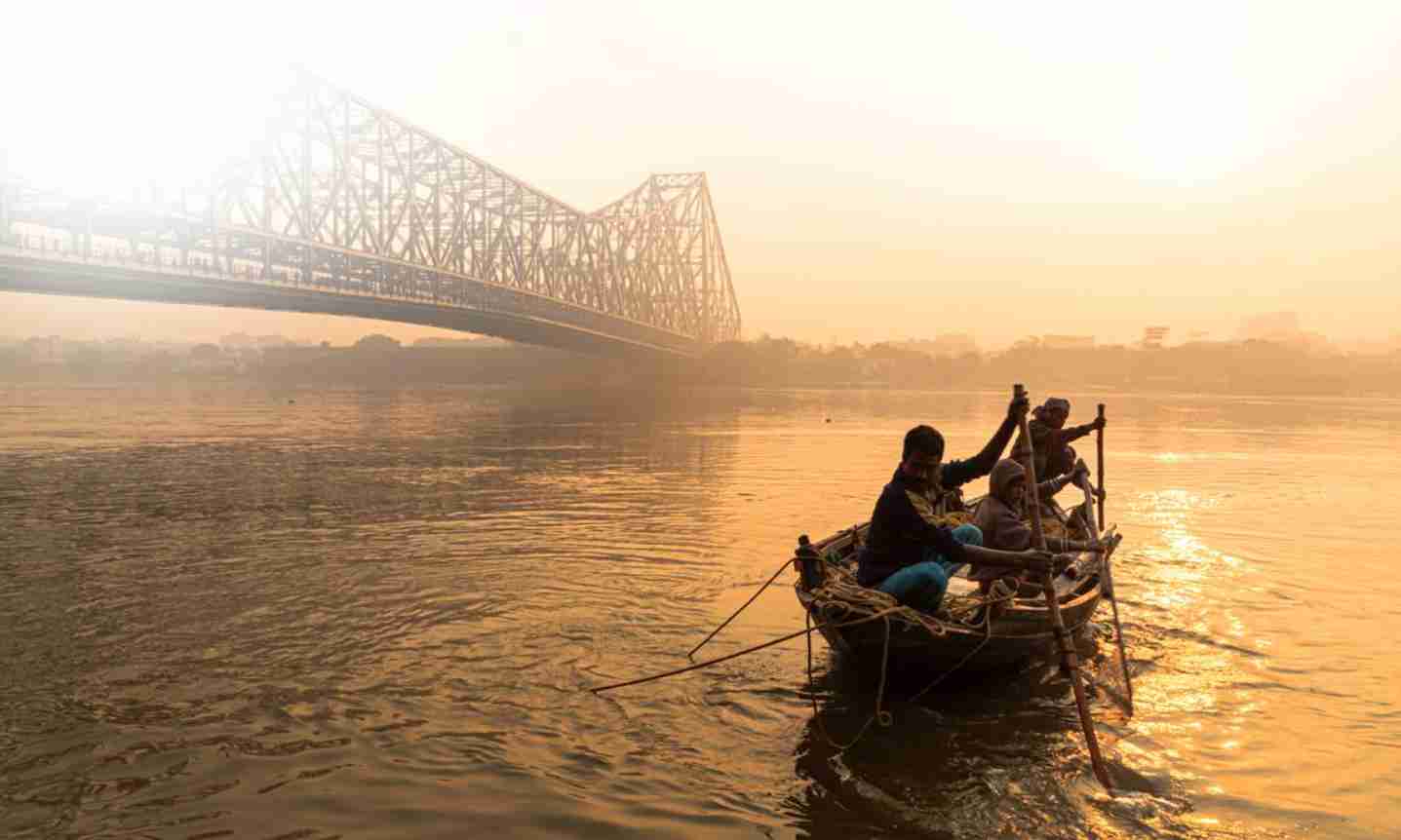
The Howrah Bridge, an iconic landmark in Kolkata, has stood the test of time and played a vital role in connecting the city to its twin city of Howrah. As technology and urbanization continue to shape the world around us, it is important to consider the prospects of this magnificent structure. Adapting the Howrah Bridge to meet the changing needs of the city and its residents is a crucial aspect of ensuring its relevance and longevity. Let’s explore some potential prospects for the Howrah Bridge:
Upgrading Infrastructure: As Kolkata continues to grow and evolve, there is a need to upgrade the infrastructure surrounding the Howrah Bridge. This includes improving road networks, expanding pedestrian walkways, and enhancing connectivity to accommodate the increasing volume of vehicles and pedestrians. Upgrading the infrastructure will not only enhance the efficiency of transportation but also improve safety and accessibility for all.
Incorporating Sustainable Features: With sustainability becoming a global priority, integrating eco-friendly features into the Howrah Bridge can have a significant impact. This may include installing solar panels to generate renewable energy, implementing rainwater harvesting systems, and incorporating green spaces or vertical gardens to enhance the bridge’s aesthetics and promote environmental conservation.
Enhancing Safety Measures: The safety of pedestrians, motorists, and commuters should be a top priority when considering the future of the Howrah Bridge. Implementing advanced safety measures such as CCTV surveillance, smart traffic management systems, and structural monitoring technologies can ensure the bridge’s structural integrity and enhance the overall safety and security of those who use it.
Promoting Tourism and Cultural Experiences: The Howrah Bridge is not only an important transportation link but also a significant tourist attraction. Enhancing the bridge’s surroundings with well-designed promenades, viewing decks, and recreational spaces can provide visitors with a memorable experience and further promote tourism in the area. Additionally, organizing cultural events, exhibitions, and performances on or near the bridge can showcase the rich cultural heritage of Kolkata and engage both locals and tourists.
Incorporating Smart Technologies: Embracing smart technologies can greatly enhance the efficiency and functionality of the Howrah Bridge. Implementing intelligent transportation systems, such as real-time traffic monitoring, smart signage, and automated toll collection, can optimize traffic flow and reduce congestion. Integration with mobile applications and digital platforms can provide real-time information to commuters, improving their travel experience and minimizing travel times.
Supporting Sustainable Transportation: Encouraging sustainable transportation options can help reduce congestion and improve air quality near the Howrah Bridge. This can be achieved by providing dedicated lanes for bicycles and pedestrians, promoting electric and hybrid vehicle usage, and improving connectivity to public transportation systems. Creating a more pedestrian-friendlier and environmentally conscious environment around the bridge will contribute to a greener and more liveable city.
Preserving Architectural Heritage: As plans for the future of the Howrah Bridge are developed, it is crucial to preserve its architectural heritage. Any modifications or additions should be carried out in a way that respects and enhances the bridge’s original design and historical significance. Balancing the need for modernization with the preservation of the bridge’s unique identity will ensure its continued cultural and historical importance.
The prospects for the Howrah Bridge involve adapting it to meet the changing needs of Kolkata while preserving its architectural heritage. Upgrading infrastructure, incorporating sustainable features, enhancing safety measures, promoting tourism and cultural experiences, embracing smart technologies, supporting sustainable transportation, and preserving its architectural charm are key considerations. By carefully planning and implementing these prospects, the Howrah Bridge can continue to serve as an essential link, a symbol of the city’s heritage, and an iconic landmark for generations to come.
Conclusion
Howrah Bridge stands tall as a timeless symbol of Kolkata, captivating both locals and tourists alike. Its rich historical background, remarkable architectural marvel, and iconic status have contributed to its enduring legacy. As we have explored its origins, design, and construction, we have come to appreciate the engineering brilliance that went into creating this magnificent structure.
Beyond its functional purpose, Howrah Bridge has become an integral part of Kolkata’s identity. It has transcended its role as a mere transportation route to become an inspiration for art, literature, and cinema. Artists, writers, and filmmakers have immortalized the bridge, showcasing its beauty and significance to the world.
The bridge’s allure extends beyond the realms of culture and art; it holds immense value as a tourist attraction. Its distinctive silhouette, seen against the backdrop of the Hooghly River, draws visitors from far and wide. It has witnessed countless memorable events and celebrations, solidifying its place in the hearts of the people.
To ensure the longevity of this architectural gem, the preservation, and maintenance of Howrah Bridge have been of utmost importance. The authorities have taken diligent steps to safeguard its structural integrity while adapting it to meet the changing needs of the city. By doing so, they have ensured that future generations can continue to marvel at this remarkable feat of engineering.
The numbers associated with Howrah Bridge are truly impressive, showcasing its scale and significance. With its massive length, weight-bearing capacity, and the sheer number of people and vehicles that traverse it daily, the bridge remains an awe-inspiring testament to human ingenuity.
Looking ahead, the future prospects for Howrah Bridge are promising. As Kolkata evolves, the bridge must adapt to changing needs. It has the potential to serve as more than just a means of transportation; it can be transformed into an urban space that caters to the diverse needs of its residents and visitors. By embracing innovation while preserving its historical essence, Howrah Bridge can continue to be a beacon of progress and inspiration.
Howrah Bridge is not just a steel and concrete structure; it is a living testament to Kolkata’s history, culture, and resilience. It has stood the test of time, connecting people, shaping transportation, and leaving an indelible mark on the city’s landscape. Howrah Bridge will forever remain an iconic symbol of Kolkata’s past, present, and future, inspiring generations to come with its grandeur and magnificence.
Top 13 Facts About Howrah Bridge
Howrah Bridge, an architectural marvel, is not just a bridge but an engineering wonder that has captivated the world with its magnificent design and construction.
With its origins dating back to the early 20th century, Howrah Bridge carries a rich historical background, tracing its roots to the colonial era of Kolkata.
The construction and design of Howrah Bridge involved a team of brilliant engineers and skilled workers who worked tirelessly to create this iconic structure, which stands as a testament to human ingenuity.
Howrah Bridge played a transformative role in the transportation landscape of Kolkata, connecting the two bustling parts of the city and significantly easing the movement of people and goods.
As a symbol of Kolkata, Howrah Bridge has not only become an integral part of the city’s skyline but has also made its way into various forms of art, literature, and cinema, serving as a backdrop for countless creative works.
The iconic status of Howrah Bridge has made it a must-visit landmark for tourists from around the world, who are enchanted by its architectural beauty and the panoramic views it offers of the Hooghly River.
The preservation and maintenance of Howrah Bridge are of paramount importance to ensure its longevity. Regular inspections, repairs, and conservation efforts are carried out to protect this engineering masterpiece from the passage of time.
Howrah Bridge boasts impressive numbers, including its staggering length, weight-bearing capacity, and the massive volume of vehicles and pedestrians that cross it daily, making it a truly remarkable structure.
The bridge has witnessed numerous iconic moments throughout its existence, playing host to memorable events and celebrations that have become an integral part of Kolkata’s cultural fabric.
Looking ahead, the future prospects of Howrah Bridge involve adapting it to meet the changing needs of Kolkata. It has the potential to transform into a multifunctional urban space, accommodating the evolving demands of the city and its residents.
Howrah Bridge is not just a physical entity; it is a symbol of Kolkata’s resilience, connecting generations and bridging the gaps between the past, present, and future of the city.
The bridge’s intricate latticework, which allows it to withstand strong winds and seismic activities, is a testament to the engineering brilliance and innovative techniques employed during its construction.
Howrah Bridge continues to stand tall as a source of inspiration, reminding us of the power of human imagination and the ability to create enduring structures that leave a lasting impact on society.
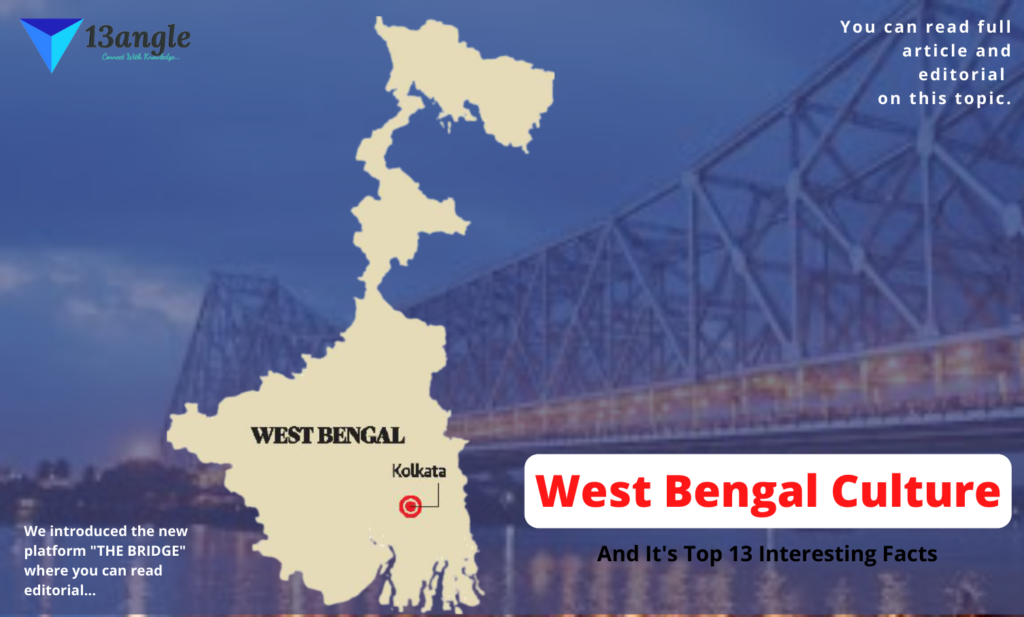
West Bengal Culture

Bengali Film Industry




